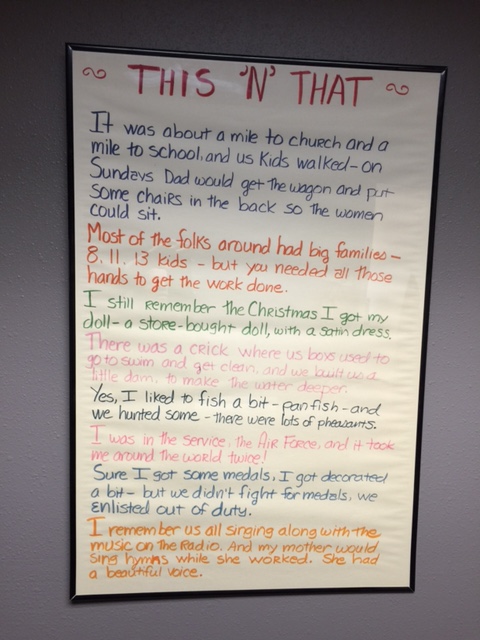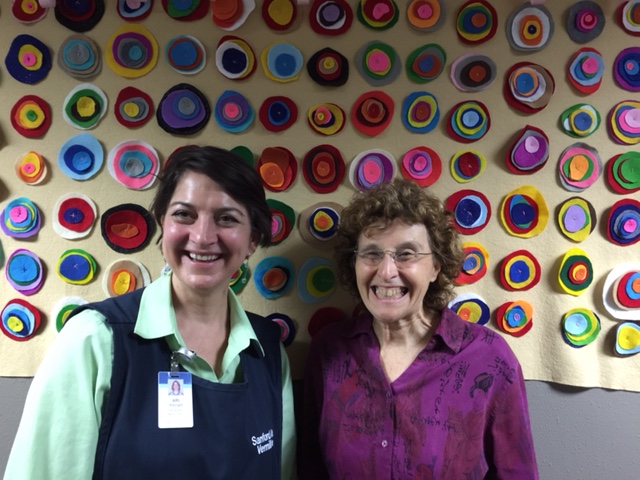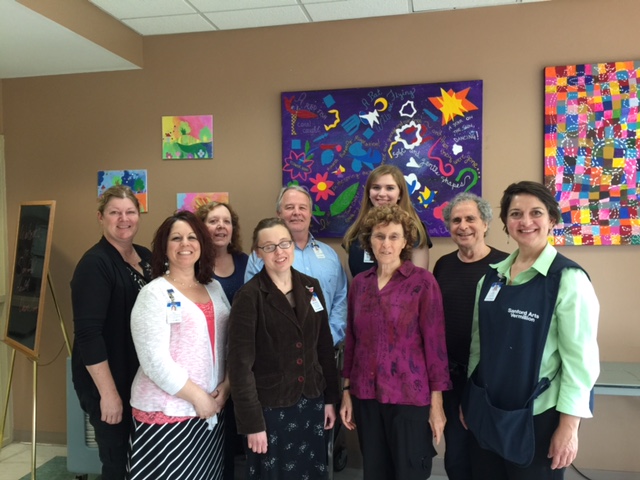Posts Tagged ‘Sanford Arts Vermillion’
Two Secrets to Creating a Thriving Dementia Care Community: Arts and Collaboration
“Art is the vehicle for creating connection and community,” Ari Albright said, as we toured her eclectic art studio/teaching space in Vermillion, South Dakota. Ari serves as Program Coordinator and Artist-in-Residence for Sanford Arts Vermillion (SAV), located at Sanford Vermillion Medical Center. We’d read about her innovative approach to arts and dementia and we wanted to learn more. During our visit, we witnessed much more than an arts program. From the executive team to the nursing team to the dietary staff, we experienced a powerful spirit of collaboration and a dedication to enriching the residents’ lives through the arts. This sense of purpose permeated Sanford Vermillion Medical Center, which contains a hospital, clinic, independent living center, and a long term care facility, complete with a special care dementia unit.
After our tour of her studio, Ari led us over to the facility’s boardroom, where we met Mary Merrigan from Public Relations, Cindy Benzel from Human Resources, and Jill Christopherson, Executive Assistant.
“Ari was brought in to enrich activities in the long term care center,” Mary told us. “Our staff completely embraced the program: it made their work less rote and more meaningful.”
Tim Tracy, CEO, dropped in to greet us. “We’re very proud of the program and of Ari,” he said. “It’s made a big difference in the lives of our residents and of our staff.”
Setting Goals and Exceeding Expectations
Since 2011, Ari has facilitated arts engagement in healthcare environments. She started doing art projects with the patients, staff, and families at the Sanford Cancer Center and Children’s Castle of Care Hospital in Sioux Falls, South Dakota. In 2012 when Ari approached Tim and his team about bringing her participatory program to Sanford Vermillion, they were interested. Tim, along with Ari and members of the executive and care teams, set three goals for the art program:
- Enrich activities for residents with dementia and special needs adults
- Uplift the environment by offering art displays on the center’s walls
- Care for caregivers by taking the redundancy out of the staff’s daily job
Ari’s program, which consisted of three to four weekly two-hour art programs that supplemented the on-going activities agenda, worked beyond their expectations. Ari trained members of the care team to become involved in art activities, both when she was there and when residents needed something soothing or meaningful to do. She worked with volunteers and family members. She created “Art Kits,” a rainbow-colored box with an easy project that a resident could do on her own.
The residents participated in every aspect of this multi-faceted textile art project, which now hangs in the special care unit. This was inspired by Wassily Kandinsky’s Color Studies.
In 2012, 30 percent of the facility’s 62 residents were taking psychotropic medications. (The national norm is between 25-30%). By the end of 2013, when the arts program had been in place for one year, only 20 percent of the 65 residents were taking the medications. Ten residents had a reduction in medications and seven simply no longer needed the drugs. In October of 2014, after two years of the arts program, only three percent were taking psychotropic medications. Reducing these strong medications enriched the residents’ quality of life in a variety of ways, including making them less susceptible to falls, increasing their alertness, and piquing their appetites. Ari’s media included painting, sand, clay, fabric, and origami. Along with the tactile and visual experiences, she wove in literary arts, music, and movement. These projects increased residents’ creative thinking, decision-making, playfulness, cooperation, conversations, patience, and sense of meaning. The families were often astonished by the creations and contributions of their loved ones. The staff felt a greater connection with the residents and an increased sense of empowerment.
“The artistic tools are only a catalyst for connection,” Ari says. “This program is about the process of doing something that feels relevant.”
 This literary arts project inspired important memories. This was facilitated by visiting SDAC Artist and writer, B.J. Buckley.
This literary arts project inspired important memories. This was facilitated by visiting SDAC Artist and writer, B.J. Buckley.
It Takes a Team To Say Yes! To Art and No to Psycho-tropic Drugs
A collaborative team of executives, management, and staff worked together to implement and integrate this arts program. Each one played an important role. The executive team paved the way, finding funding, navigating the system, and offering vital goal setting and guidance. Nursing professionals and social workers educated doctors, family, and staff on the program’s benefits and created time for staff to participate. The dietary department displayed residents’ artwork on the cafeteria walls and now hosts quarterly artists’ reception.
This is part of the team from Sanford Vermillion Medical Center that improved residents’ lives by embracing participatory arts programs in their senior living and special care communities. Back row: Kay Hoesing, MDS Coordinator; Gayle Matzke, DON; Jeff Berens, CNO; Rebecca Froehlich, SAV Intern/Volunteer; Ron Zoglin; Front row: Jill Christopherson, Executive Assistant; Melissa Langle-Lee, Social Work; Deborah Shouse; Ariadne (Ari) Albright, Program Coordinator and Artist in Residence
For more information about Ari, visit
www.arialbright.com
Facebook page: Art with Ari
For more information about the Sanford Vermillion arts program, visit:
Sanford Arts Vermillion 20 E. Plum Street, Vermillion, SD 57069
Email: Ariadne.Albright@Sanfordhealth.org
Phone: 605-638-8580
www.sanfordvermillion.org
Do you have a story about collaboration, arts and dementia? If so, I’d love to hear it!
Deborah Shouse is the author of Love in the Land of Dementia: Finding Hope in the Caregiver’s Journey.


